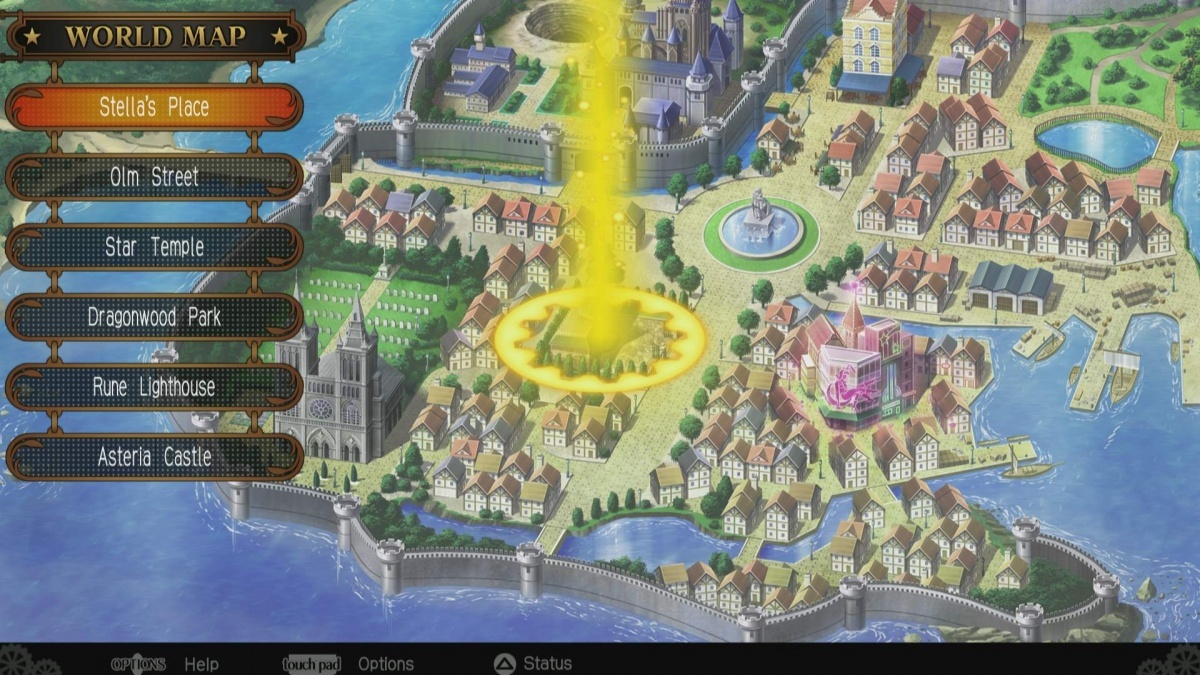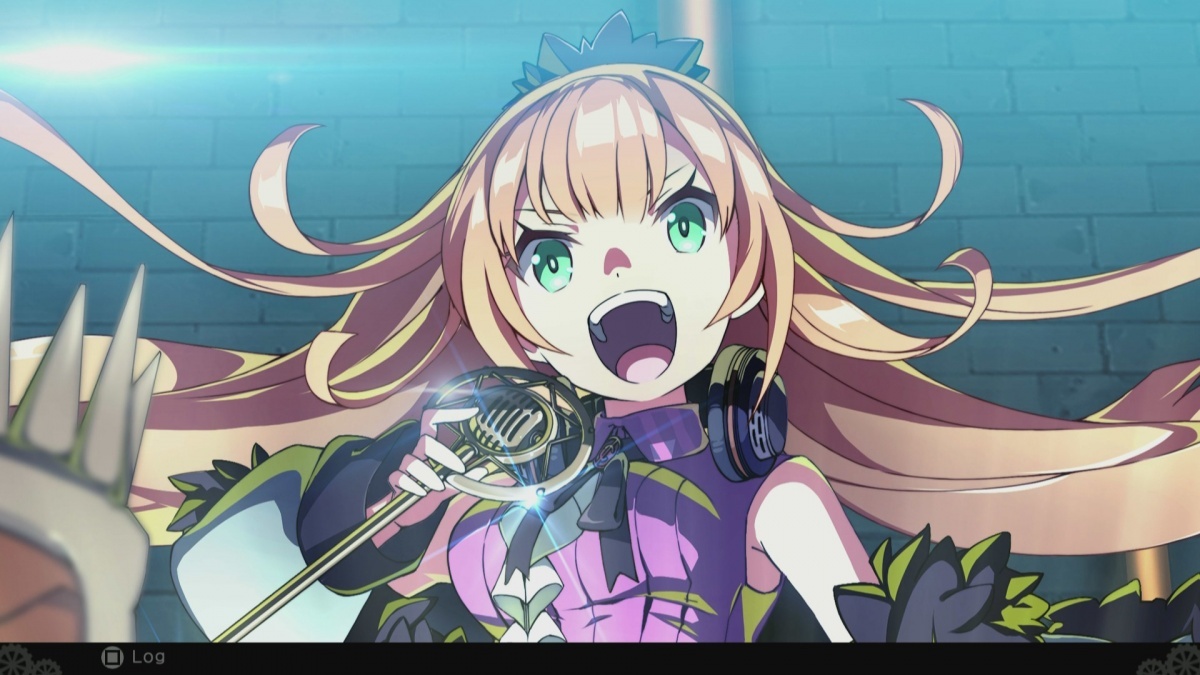Demon Gaze II (PlayStation 4) Review
By Gabriel Jones  19.11.2017
19.11.2017

Asteria, the city where industry meets fantasy, is suffering under the rule of Lord Sirius Magnastar. His unparalleled strength comes from all of the human souls he's harvested. Nobody dares to stand up to him and his demon army, except for the revolutionists. Prim, through the magic of radio, speaks of truth and justice, in the hopes that her voice will help to overthrow a tyrant. A young man with no name, who's only identifying characteristic is his mysterious eye, has become caught up in the revolution. As it turns out, his gaze can absorb the souls of demons. Perhaps he's the hero that will lead this ragtag bunch to victory.
Though Demon Gaze was a fine DRPG, it suffered from a number of problems, such as the absurdly overpowered summons, uneven boss battles, and general lack of creative party builds. Regardless, dungeon crawlers were few and far between, so it'd be a shame to kick an otherwise decent title out of bed, simply because it had a few flaws. Nowadays however, there have been quite a lot of quality releases in the genre. If the sequel was merely more of the same, then it wouldn't be able to compete. Thankfully, Experience has taken a fresh approach for Demon Gaze II. They've overhauled various aspects of the game to create something that's much more balanced and thoughtful.
As the Demon Gazer, players will explore the many restricted zones of Asteria. It's in these dread labyrinths that they'll face off against fiendish creatures and punishing traps. Oh and what dungeon would be complete without a plethora of puzzles to solve? The ultimate goal is to take control of the Magic Circles, opening a pathway into the demon's lair. Dealing with these powerful adversaries will move the storyline along, as well as unlock a new ally to recruit into the party.

This highlights one of the most significant changes in the sequel. Party members are no longer created from a blank slate. Instead, the formerly evil demons will pledge loyalty to the Gazer. It's up to the player to make the best use of their skills. Pegasus, the first of the recruits is a white knight. To put it another way, she's a tank. Her job is to protect the weaker party members. As she levels up, skills such as devotion become available, allowing her to fulfil her duty more easily. When devotion is activated, "Peg" protects everyone in whichever row she's currently stationed. It's a risky skill, because almost all of the enemies will target her, but over time it becomes invaluable for survival.
Future party members also have unique classes and skill sets. The weapons and armour available to them are also different. A wizard such as Libra won't find any use for swords and axes, but when she isn't casting spells, she can wield a handful of ranged weapons such as slings. In most cases, it's best to focus on specialization. Very few demons are capable of serving dual roles. However, there are instances where specific skills might be more beneficial when utilized with particular classes. This is where artefacts come into play. These charms can be equipped to bestow skills on a party member, enhancing their abilities, or giving them more versatility. Altogether, the new system works fantastically. Players still have some freedom to customize their party, and everyone is viable. Just be sure to allocate stat points properly when levelling up. If a character isn't capable of using magic, then there's no reason to invest points into their Intelligence statistic.

Stella's Place, the inn where all heroes return to after a dungeon excursion, has all of the expected amenities. Each of the individual bedrooms can be decorated with stat boosting furniture. Anyone familiar with the first game will recognize Cassel, who now runs both the weapon and item shop. Returning NPC Prometh resurrects dead party members and handles item storage. The maintenance room is available for improving gazer/demon relationships. Also, just in case anyone's wondering, there's no rent. Unlike Fran, Muse won't stick the party up for cash every time they come home.
Performing maintenance on a demon involves a touch-based minigame, where the player attempts to find the sweet spot on their body. It's actually less suggestive than it sounds. Poking at chests, loins, and groins won't elicit moans. As friendships build, it's possible to go out on dates. Again, don't expect much beyond the usual nonsense, such as accidental bust grabs during training sessions. In general, the fan service is toned down compared to the first game. By the way, increased friendship levels leads to stat boosts and new skills, so don't ignore them.

Though their appearances suggest otherwise, the men and women that serve the protagonist are still, in fact, demons. If circumstances demand it, the Demon Gazer can call upon a special power known as demonize. This causes all of the party members to take their true forms, enhancing their stats and opening up a slew of new abilities. Some of the special powers include raising the party's defence, or stunning the enemy with an all-out attack. Demonization requires star power to maintain, which is earned by damaging enemies. Progressing through the storyline and liberating districts will earn the player a larger star gauge. Later on, the main character can fuse with demons, becoming an almighty force of pure destruction. However, it drains the star gauge at a rapid pace, and leaves the demon in a weakened state when the fusion ends. In short, there isn't any summons, so battles no longer hinge solely on the efforts of one overwhelmingly strong ally.
Despite losing one of the key components of the original game, Demon Gaze II becomes all the better for it. This is because it's appropriately balanced for the change. There are no longer any "DPS race" bosses. Remember those fights with demons that could restore thousands of hit points every few rounds? They're gone. This dungeon crawler also has no less than five difficulty settings. It defaults to "lukewarm", which might be a little too easy, so feel free to set the difficulty to "hot". Alongside the increased level of challenge, players are also likely to obtain more valuable rewards from the equipment bestowing Magic Circles.

As is often the case in recent DRPGs, earning equipment from random battles simply isn't possible. Instead, the heroes must stock up on item gems, and then offer them to Magic Circles. After winning the ensuing battle, weapons and armour specific to the gems are awarded. Anything that the player deems useless can be thrown in Prometh's Ether Mill. The ether can then be used to strengthen the party's arsenal. Thanks to map functions such as auto-move, it's pretty easy to enter a constant cycle of gear acquisitions and upgrades. It does get pretty repetitive, but at least everything moves quickly thanks to the auto-battle and fast-forward commands.
One of the more interesting late-game additions is that Magic Circles can sometimes turn into Star Circles. Rather than gems, the Gazer offers up to three of his demonic allies. Naturally, the battle becomes a bit more difficult, but the rewards tend to be especially unique, such as rare weapons and armour. After obtaining the Orb of Darkness, even artefacts can be earned from these precious Circles. Don't hold your breath though, as that sphere won't be available until the post-game. As is usually the case for a DRPG, there's quite a lot to do even after the story is concluded. The most substantial addition is the second scenario. Titled "The Call of the Grimodar", this expansion adds three dungeons, more demons, superbosses, and all sorts of other extras.

The key word for Demon Gaze II is refinement. All of the faults in the first game have been addressed, making for an adventure that's more polished and confident. The numerous changes to demons are especially welcome, as they lend more depth to the battle system. For genre veterans, the dungeons don't really offer anything new, but they exhibit a high level of craftsmanship. They're appropriately paced and the puzzles found throughout are involving, but never overbearing. It does take some time before the challenge starts to ramp up, but there aren't any ridiculous brick walls that require hours of grinding to overcome.
That said, it's still very easy to get caught up in the grind. Strengthening gear requires a lot of ether, and some players just love to watch numbers rise. This does take some of the focus away from battles and exploration. Cruising through hundreds of random encounters and even a few bosses can lead to complacency. Utilizing mechanics such as fusion will become vital after a certain point, and sometimes raw numbers simply aren't enough. If they're not adequately versed in strategy, one might find themselves struggling to overcome the odds.
If the player's only interest is in seeing the main story to its conclusion, while enjoying a dungeon crawler, then this title is still certain to appeal to them. The easier difficulty settings allow the freedom to test unoptimized party configurations and rush through most battles. If they're feeling confident, then they can always turn the "heat" up. Even games in niche genres can benefit from being as inclusive as possible.

Cubed3 Rating
Great - Silver Award

In every respect, Demon Gaze II is a superb follow-up. The revamped demon system makes for a much more involved and fulfilling adventure. Players are no longer obligated to build their entire offense around one or two mechanics, which lends battles a greater degree of flexibility. The storyline isn't particularly complex or thrilling, but it's at least adequate. All of the characters fit into standard tropes, yet they're also earnest and even endearing. Of course, this is all secondary to the great dungeon design and battle system. This entry has succeeded in carving out an identity in an increasingly crowded market.

![]() 8/10
8/10
![]() 0
(0 Votes)
0
(0 Votes)
 Out now
Out now  Out now
Out now  Out now
Out now  Out now
Out now Comments
Comments are currently disabled

 Sign In
Sign In Game Details
Game Details Subscribe to this topic
Subscribe to this topic Features
Features





 Top
Top

